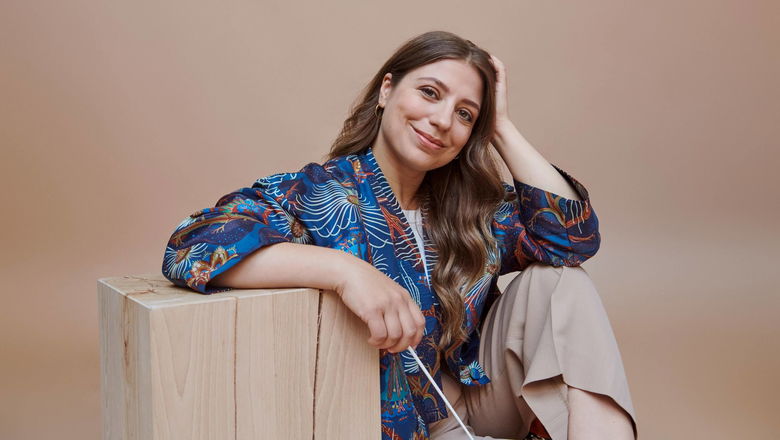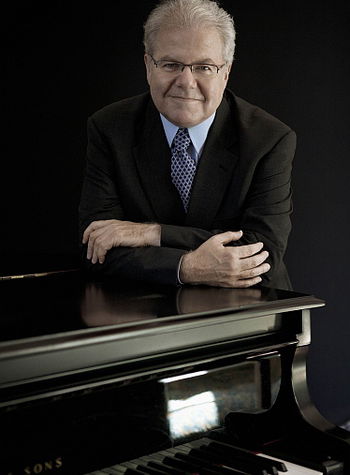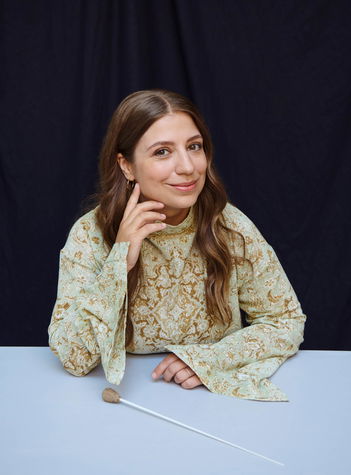Programme
Wolfgang Amadeus Mozart
Piano Concerto No. 25 in C major, K 503 (39')
— Intermission —
Jean Sibelius
Finlandia, symphonic poem, Op. 26 (9')
Jean Sibelius
Symphony No. 5 in E flat major, Op. 82 (32')
Secure your seat for the 2025/2026 season – presales are open.
Choose SubscriptionExactly 10 years since his last appearance, the Czech Philharmonic is welcoming the legendary American pianist Emanuel Ax. At the invitation of the conductor Franz Welser-Möst, he will play the Piano Concerto No. 25 by his beloved Mozart. Welser-Möst will not attend the subscription week at the Rudolfinum due to illness. The concerts will be led by the chief conductor of the Lahti Symphony Orchestra, artistic director of the Jean Sibelius International Festival and principal guest conductor of the BBC Symphony Orchestra, Dalia Stasevska.
Subscription series C | Duration of the programme 1 hour 40 minutes
Wolfgang Amadeus Mozart
Piano Concerto No. 25 in C major, K 503 (39')
— Intermission —
Jean Sibelius
Finlandia, symphonic poem, Op. 26 (9')
Jean Sibelius
Symphony No. 5 in E flat major, Op. 82 (32')
Emanuel Ax piano
Franz Welser-Möst conductor
Dalia Stasevska conductor
Czech Philharmonic

Emanuel Ax piano

“Within minutes, we are totally captured by his intensity and pianistic achievement,” wrote the Los Angeles Times about the 74-year-old pianist Emanuel Ax. “Manny”, as he is sometimes called, is regarded as one of today’s most sincere and modest artists despite having been in the limelight of the worldwide music scene since 1974, when he won the inaugural Arthur Rubinstein International Piano Competition in Tel Aviv. He even has a fan club, “Manny Ax Maniacs”, the members of which wear t-shirts bearing the club’s name to his concerts.
Emanuel Ax was born in Poland, but as a young child he moved with his parents first to Canada, then to New York. There, he studied at the Juilliard School, where he now teaches, and he gave his concert debut as part of the Young Concert Artists Series. Victory at the Rubenstein Competition along with the Michaels Award of Young Concert Artists and the Avery Fischer Prize catapulted him onto the concert stage, where he achieved success of the highest order as a soloist and in chamber music.
Also of importance to his career was his partnership with the Sony Classical label, for which he has been recording exclusively since 1987. He even won a Grammy for his second and third albums in a series of Haydn piano sonatas. He also won this most prestigious of recording prizes for albums of the Beethoven and Brahms sonatas for cello and piano, which he recorded with Yo-Yo Ma, his long-time artistic partner. Ax, Yo-Yo Ma, and Leonidas Kavakos also recently launched an ambitious project to play all of Beethoven’s piano trios as well as his symphonies arranged for those forces. They are now promoting the project, known as “Beethoven for Three”, with live concert performances. So far, they have recorded symphonies nos. 2, 5, and 6 along with the Op. 1 piano trios.
Besides the traditional repertoire (or arrangements of it), he also devotes himself very intensively to premiering new works by contemporary composers. For example, he has been the first to play new works by such composers as Krzysztof Penderecki and John Adams; in October 2023 he gave the premiere of Anders Hillborg’s Piano Concerto No. 2, “The MAX Concerto”, written by that contemporary Swedish composer on commission for the San Francisco Symphony led by Esa-Pekka Salonen. In addition, this season has featured a European tour (mainly with the Concertgebouw Orchestra and the Bavarian State Orchestra) and a series of Beethoven-Schoenberg recitals around the USA, where Ax lives (in New York) with his wife, the pianist Yoko Nozaki.
Dalia Stasevska conductress

Dalia Stasevska, the chief conductor of the Lahti Symphony Orchestra in Finland, the artistic director of the Lahti International Sibelius Festival, and the principal guest conductor of the BBC Symphony Orchestra, was predestined to be a musician from an early age thanks to her parents. She devoted herself intensively to violin playing, but then at age 13 she heard a symphony orchestra for the first time, and the sound thrilled her. She soon began to study scores and to play the violin parts along with recordings—her desire was to be part of the orchestra. She was also fascinated by opera, which was something she did not hesitate to talk about at school: “My friends were listening to the Spice Girls and Backstreet Boys, but I just wanted opera. Whenever we had to do some kind of show and tell at school about what interested us I would always talk about opera. People would boo me, but I’d say ‘No! – Just listen to this magnificent music!’ I knew it was special and I was happy to be different.” The next important event in her musical development occurred at age 20, when she first saw a woman conducting. Until then, it had never occurred to her that besides playing the violin and composing, she could also go down that path. She registered in Jorma Panula’s conducting masterclass, and since then, as she says, she “never let go of the baton”.
After attending the conservatoire in Tampere, Finland, she studied violin, viola, and conducting at the Sibelius Academy. She is now famous not only in the Nordic countries (she was born in the Ukraine, but she has been living in Finland since the age of five), but also all over Europe and the USA. She collaborates regularly with such orchestras as the New York Philharmonic, the Los Angeles Philharmonic, the San Francisco Symphony, the Netherlands Radio Philharmonic Orchestra, and the Deutsches Symphonie-Orchester Berlin. With the BBC Symphony Orchestra, she toured Japan in the autumn of 2022, and she has already appeared twice at the opening concert of the BBC Proms. They also recently released their joint debut album titled Dalia’s Mixtape, which reveals the conductor’s fascination with contemporary music.
She is an energetic proponent of contemporary works, especially with her “own” Lahti Symphony Orchestra. She routinely performs the music of such composers as Missy Mazzoli, Thomas Adès, Kaija Saariaho, and Outi Tarkiainen. Last season with the Czech Philharmonic, she stood in for the conductor Franz Welser-Möst, performing works by Jean Sibelius and others. At today’s Open Air Concert, she is following up on her busy season, which she has spent with orchestras including the Orchestre de Paris, L’Orchestra dellʼAccademia Nazionale di Santa Cecilia, the Oslo Philharmonic, the Swedish Radio Symphony Orchestra, and the San Francisco Symphony.
Wolfgang Amadeus Mozart
Piano Concerto No. 25 in C major, K 503
When Wolfgang Amadeus Mozart wrote his Piano Concerto No. 25 in C major, K 503, did he realise that listeners were unprepared for his conception of the concerto genre and that the work would spend a full 147 years on its journey back to the concert stage? The composer performed the concerto in Vienna on 5 December 1786, a day after its completion, then the following year he repeated his performance and also played the concerto in Leipzig. After that, it was not heard again at a concert until 1934, when Artur Schnabel played the solo part with the Vienna Philharmonic led by George Szell. It took another ten years for the work to solidify its place in the piano repertoire, and it has come to be viewed entirely differently—we now regard it as one of Mozart’s most magnificent works, paving the way in the genre not only for Beethoven, but also for the whole 19th century. The Czech Philharmonic recorded this concerto in 1974 on the Supraphon label with the legendary Mozart interpreter Ivan Moravec under the baton of Josef Vlach.
Mozart began devoting himself to the piano concerto genre at around age 20, modelling works after known examples by Georg Christoph Wagenseil (1715–1777), who was active in Vienna, and Johann Christian Bach (the “London Bach”, 1735–1782). During his years of success from 1784 to 1786, when he wrote 12 piano concertos numbered among his masterpieces, he engaged in polemics with his predecessors on the pages of his scores, advancing the genre beyond merely entertaining, pleasingly predictable pieces for high society. He often composed with himself in mind as the performer, he took more notice of the colours of the instrumental sections, and his content reached surprising depths, where even complex counterpoint flows along in the currents.
In his Piano Concerto No. 25, Mozart truly broke new ground, and for the purpose he chose the heroically triumphant key of C major to avail himself of the brilliance of trumpets and timpani (whilst foregoing his beloved clarinets). The work exhibits perfect unity in diversity and is unusually symphonic and polyphonic for its day, especially in the opening Allegro maestoso, where we witness many contrasts of expression. In the middle section, the composer seems to have a premonition of the melody of the Marseillaise, which was not written until 1792, nearly six years after the concerto was finished. The slow movement that follows is an echo of the lovely tenderness of Mozart’s operatic duets, with the piano engaging in a heartfelt dialogue mainly with the wind instruments. The concluding rondo Allegretto begins with a dance theme from the composer’s opera Idomeneo. Although serious ideas are concealed beneath the typically exciting Mozartian energy, the concerto proceeds optimistically. The concerto’s exceptional craftsmanship is worthy of comparison to Mozart’s very last symphonic work, the Symphony No. 41 in C major “Jupiter”, K 551 (1788).
Jean Sibelius
Finlandia, symphonic poem & Symphony No. 5
Jean Sibelius, given the name Johan Julius Christian by his parents and known as Janne, was born in Hämeenlinna, a city in southern Finland. In those days, the country belonged to the Russian Empire as a more-or-less autonomous grand duchy. After a long coexistence in a single administrative state with the Kingdom of Sweden, by the 19th century the Finnish people were distancing themselves both from persisting Swedish influence and—later on—from Russification, and the country experienced its national awakening. Culture, language, mythology, and heroic historical events all played an important role. Sibelius himself grew up in a Swedish-speaking environment, and he had to find his way to the Finnish language. He was helped in doing so by the Karelian-Finnish epic poem Kalevala, compiled on the basis of the oral traditions of the Karelians and Finns and published in its definitive version in 1849. The young Sibelius was captivated by the Kalevala, and while not Finland’s first composer, he became the most important. He completed his musical studies at the conservatoire in Helsinki in 1889, then he left for further studies in Berlin and Vienna. Upon his return home (1892), he married Aino Järnefelt from an important family with a “pro-Finnish” orientation.
Stories from the Kalevala and their atmosphere continually found their way into Sibelius’s works, whether his symphonic poems Kullervo, Op. 7, Lemminkäinen, Op. 22 (a cycle of four legends associated with the character Lemminkäinen), or Tapiola, Op. 112 (1924). Sibelius also had a very sensitive awareness of the natural beauty of the north, something to which he always enjoyed returning. In the title of the symphonic poem Finlandia, Op. 26, it is as if his sources of inspiration—the ancient world of bardic singers, the nation’s struggle for freedom, and the grandeur of nature—had merged together, although the work’s genesis is remarkable for a different reason. The music had originally been composed in 1899 as an accompaniment to tableaux vivants that were staged in early November in Helsinki as a protest against press censorship imposed by the Russians. The sixth part (Finland Awakens) and the fifth part (The Great Hostility) provided the musical material for the final version of Finlandia (1900). Understandably, the work’s title also crystalised with the search for politically acceptable variants like Happy Feelings at the Awakening of Spring, A Scandinavian Choral March, La Patrie, or Impromptu, until Axel Carpelan proposed the final title. Finlandia begins with a sorrowful two-note motif, and the whole opening passage (Andante sostenuto) exhibits a spirit of grave pathos. It ends with a rhythmically forceful call to arms (Allegro moderato) that is defiant but not tragic. It is the hymnlike part, however, that gained the greatest popularity; its melody, supplied with a text, has lived a life of its own and even had a chance to become Finland’s national anthem.
The oldest professional orchestra in Helsinki, founded in 1882 by the conductor and composer Robert Kajanus, devoted itself systematically to performing Sibelius’s compositions. A surprising number of Czech musicians, especially wind players, were seated in the orchestra. In 1900, the large orchestra toured Sweden, Norway, Denmark, Germany, the Netherlands, and Belgium on its way to the Exposition Universelle in Paris, where it gave two concerts presenting a selection of works by Finnish composers including Sibelius, who took part in the tour as the second conductor. Besides Finlandia, the programme also included Sibelius’s Symphony No. 1 and the Lemminkäinen legends. The tour was meant to showcase the high level of culture of a country that was facing increased pressure from Russia at the beginning of the new century.
Jean Sibelius’s personality was characterised by a certain restlessness that compelled him to travel and to cling passionately to his many vices. Sometimes this made life for his large family difficult (the last of his six daughters, Heidi, was born in 1911) and led to the incurring of debt. Then on the other hand he was afflicted by periods of loneliness and gloom. He was perceived as the founder of the Finnish nation’s music and also as a composer of serious symphonic works of worldwide importance. With a bit of a stretch, one can even find the magical number of nine symphonies if one includes Kullervo (his first unnumbered symphony) and the Eighth, on which Sibelius was still working in the 1930s without finishing it or even leaving behind substantial sketches. The Symphony No. 5 in E flat major, Op. 82, is one of his most famous works. Written during the First World War, the first version was premiered in 1915 in connection with celebrations of Sibelius’s 50th birthday, a second version was played a year later, and the final version was premiered in 1919. In each case, the composer conducted. Work on the symphony thus lasted beyond the dramatic wartime period and other historic events—the creation of the independent Finnish state (1917) and the civil war. After the dark Fourth Symphony (1911), Sibelius was taking inspiration mainly from nature, as shown by often quoted entries in his diary: uplifting nature (“One of my greatest experiences! Lord God, that beauty!”), but also the coarser side of nature (“I’ve got a beautiful theme for an Adagio – earth, worms and misery, fortissimo and mutes, a lot of mutes! And godlike notes!!! I rejoice and tremble with excitement as my soul is singing.”). The work exhibits Sibelius’s masterful orchestration, his attitude towards musical developments represented, for example, by the Impressionists or Schoenberg, and also his critical approach to his own music, shown in part by his recasting of the symphony from the original four movements into three. Whatever part of the work may speak to us, we shall probably not forget how it ends: six chords separated by silence, opening up an infinity of space.
Exactly 10 years since his last appearance, the Czech Philharmonic is welcoming the legendary American pianist Emanuel Ax. At the invitation of the conductor Franz Welser-Möst, he will play the Piano Concerto No. 25 by his beloved Mozart. Welser-Möst will not attend the subscription week at the Rudolfinum due to illness. The concerts will be led by the chief conductor of the Lahti Symphony Orchestra, artistic director of the Jean Sibelius International Festival and principal guest conductor of the BBC Symphony Orchestra, Dalia Stasevska.